- 1Institute of Radio Astronomy, Kharkiv, Ukraine
- 2Institute of Geophysics, Gravimetrical Observatory, Poltava, Ukraine
- 3Catholic University of Leuven, Leuven, Belgium
- 4University of Maria Curie-Skłodowska, Lublin, Poland
- 5Royal Observatory of Belgium, Brussels, Belgium
An analysis of the observational polarization properties of the decameter spikes is presented in the paper. It is shown that decameter spikes possess high degree of circular polarization with average value of about 60%. In the frames of “leading spot” theory we associated the spikes activity with a certain active region on the solar disk and determined the mode of the emission. Supposing plasma emission mechanism we link and determine coronal plasma and fast electron beam parameters.
1 Introduction
Solar radio spikes have been observed and analyzed for more than half a century (De Groot, 1960; Elgaröy, 1961). These bursts are observed in a wide frequency band from several MHz up to units of GHz (Casillas-Pérez et al., 2019). The comprehensive information about their spectral properties (duration, bandwidth, flux and frequency drift rate) can be found in the following articles (Messerotti et al., 1985; Benz, 1986; Guedel and Benz, 1990; Jin et al., 1990; Magdalenić et al., 2006; Melnik et al., 2014; Bouratzis et al., 2016; Casillas-Pérez et al., 2019; Tan et al., 2019).
The present paper is devoted to another important, but poorly studied spikes parameter, the polarization. The sense and degree of spikes polarization, along with other parameters, can help us to associate them with a certain active region on the solar disk, find possible emission mechanism and give additional information about plasma parameters in the place of bursts generation.
The first attempts to associate solar radio noise storms with active regions on the solar surface were made in the late 1940th (Appleton and Hey, 1946; Allen, 1947). In those papers authors suggested that the noise storms are most likely associated with the largest sunspot group closely located around central meridian. In the paper (Payne-Scott and Little, 1951) authors were able to measure polarization and apparent position of the noise storms sources. Based on the obtained data they came to the conclusion that the size of the largest spot in a group is more likely responsible for the formation of the noise storm rather than the size of the group. Moreover, it was found that the location of the spot (northern and south hemisphere) is tightly connected with the sense of polarization. Thus authors showed that in the majority of the cases the emission associated with the spot of southern polarity was right-handed circular polarized, and associated with the spot of northern polarity was left-handed circularly polarized. Also it was supposed that the emission withright or left polarization associated with the spot of southern or northern polarity respectively corresponded to the ordinary mode of the electromagnetic wave received on Earth. Subsequently this observational regularity was called the “leading spot” rule.
For today it is generally accepted that both spikes and their groups (storms) do not always possess high degree of circular polarization and can be left or right handed polarized (De Groot, 1960; Kai, 1970; Barrow and Saunders, 1972; Abrami, 1976; Chernov, 1977; Heyvaerts et al., 1978; Messerotti et al., 1985; Benz, 1986; Benz and Guedel, 1987; Gary et al., 1991; Guedel and Zlobec, 1991; Benz et al., 1996; Wang et al., 1999). However, despite on the degree and sense of the polarization, spikes have characteristic set of common parameters (De Groot, 1960; Wang et al., 1999). In the paper (Guedel and Zlobec, 1991) it was shown that spikes polarization degree can vary depending on the location of the active region on the solar disk. Thus, when the active region moves from the limb toward the central meridian spikes polarization increases. At the same time Wang, Fu, Xie, and Huang (1999) did not find any dependencies. Regarding the preferred emission mode of spikes (O- or X-) there is still no definite answer. In different papers authors reveal both O- and X-waves with a slight prevalence of O- waves. It is also necessary to note that in the papers (Abrami, 1976; Messerotti et al., 1985; Guedel and Zlobec, 1991; Benz et al., 1996) the polarization properties of the Type III and IV bursts associated with spikes were analyzed. It was found that during one event the sign of Type III and IV bursts polarization does not always coincide with the sign of associated spikes and their degree of polarization is significantly lower. In the case of a single Type I storm, which consists of numerous short-lived spike bursts (Kai et al., 1985), it was shown that among predominant right-handed polarized bursts sparse bursts with left-handed polarization can be observed (De Groot, 1960). Author came to the conclusion that most probably it was due to superposition of two storms from different spots with different configuration of magnetic fields.
In the present paper the analysis of the spikes observed on 14 June 2012 is continued (Shevchuk et al., 2016). On that day the storm of spikes was observed simultaneously with the storm of Type III bursts followed by the Type IV burst. Based on the assumptions made in the paper we evaluated coronal plasma temperature (
2 Observations
The data analyzed in the present paper were obtained with the URAN-2 (Ukrainian radio telescope of decameter wavelength range), which is the second by size and sensitivity in Ukraine. Detailed information about this radio telescope is presented in the paper (Megn et al., 2003; Brazhenko et al., 2005). It must be mentioned that URAN-2 consists of 512 broadband cross-dipoles arranged in the form of two orthogonal dipoles rotated at an angle 45° to the meridian. Such antenna configuration together with using digital spectro-polarimeter DSP-Z (Zakharenko et al., 2016) as the back-end enables to measure the degree and sense of circular polarization. This allows studying not only time, frequency and power but also polarization properties of theradio bursts.
On 14 June 2012 observations were carried out in the interval of ±5 h from the local noon with time-frequency resolutions of 4 kHz and 100 m, respectively. More than 34 GB of observational data were obtained. Storms of spikes and Type III bursts as well as Type IV bursts were registered (Shevchuk et al., 2016). In Figure 1 the half-hour fragment of the dynamic and polarization spectra from 10:16 up to 10:46 UT is presented.
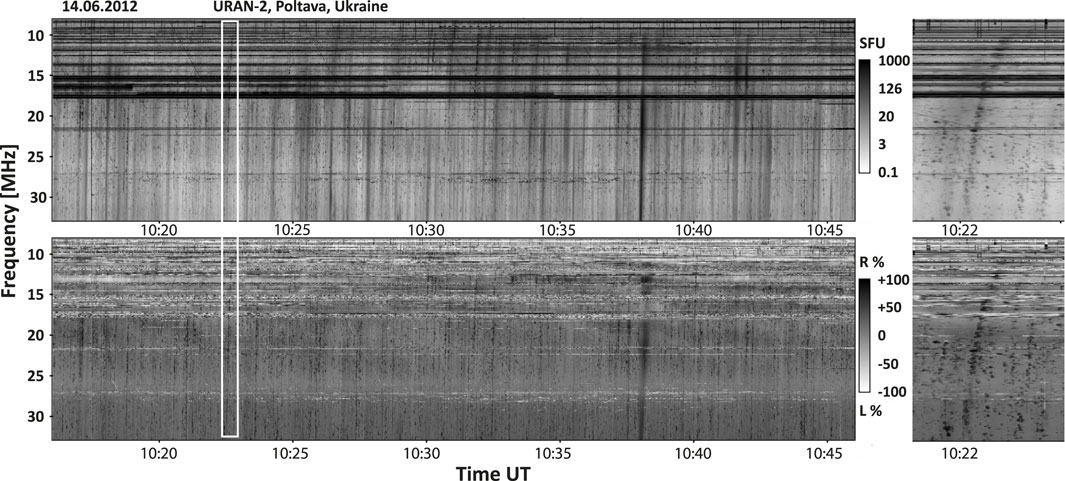
Figure 1. Half-hour fragment of the dynamic and polarization spectra obtained with URAN-2 radio telescope on 14 June 2012.
A prompt and obvious conclusion can be drawn from the shown figure during that 30-min interval that the majority of the radio bursts (spikes, Type IIIb and III bursts) had a right handed circular polarization.
In the next sections the answers for the following questions will be given: what is the degree of spikes polarization and whether it changes from spike to spike; whether the sign of spikes polarization changes during the event; is there any dependence between polarization and observational frequency, etc. Also, in the scope of this paper, we made an attempt to associate spikes with the certain active region on the solar disk and to determine the possible mode of the emission by applying the “leading spot” rule. In Section 4.2 we estimate the magnetic field based on the results presented in the paper (Melnik et al., 2018).
3 Analysis of the observational data
Since the processing of the observational data was carried out manually we randomly selected several 30 s intervals for the analysis. It should be also noted that during the selected intervals the affect of the accompanied bursts (IIIb and III) on spikes was minimal. Thus, for each interval more than 380 spikes were analyzed. For each burst the polarization and emission flux were measured by finding the maximum value of both at certain frequency and time (see, for example, Figure 3). As a result the polarization properties for more than 1,500 bursts were obtained.
As it was mentioned earlier, the majority of spikes (94%) had right-handed circular polarization. At the same time, the small number of bursts with left-handed polarization was also observed within each of the selected intervals. However, the minority of spike bursts (only 4%) had left-handed polarization. In Figure 2 the distribution of spikes on their polarization for all analyzed bursts is presented. Similar histograms were obtained for each time interval (see, for example, Figures 2B, C).
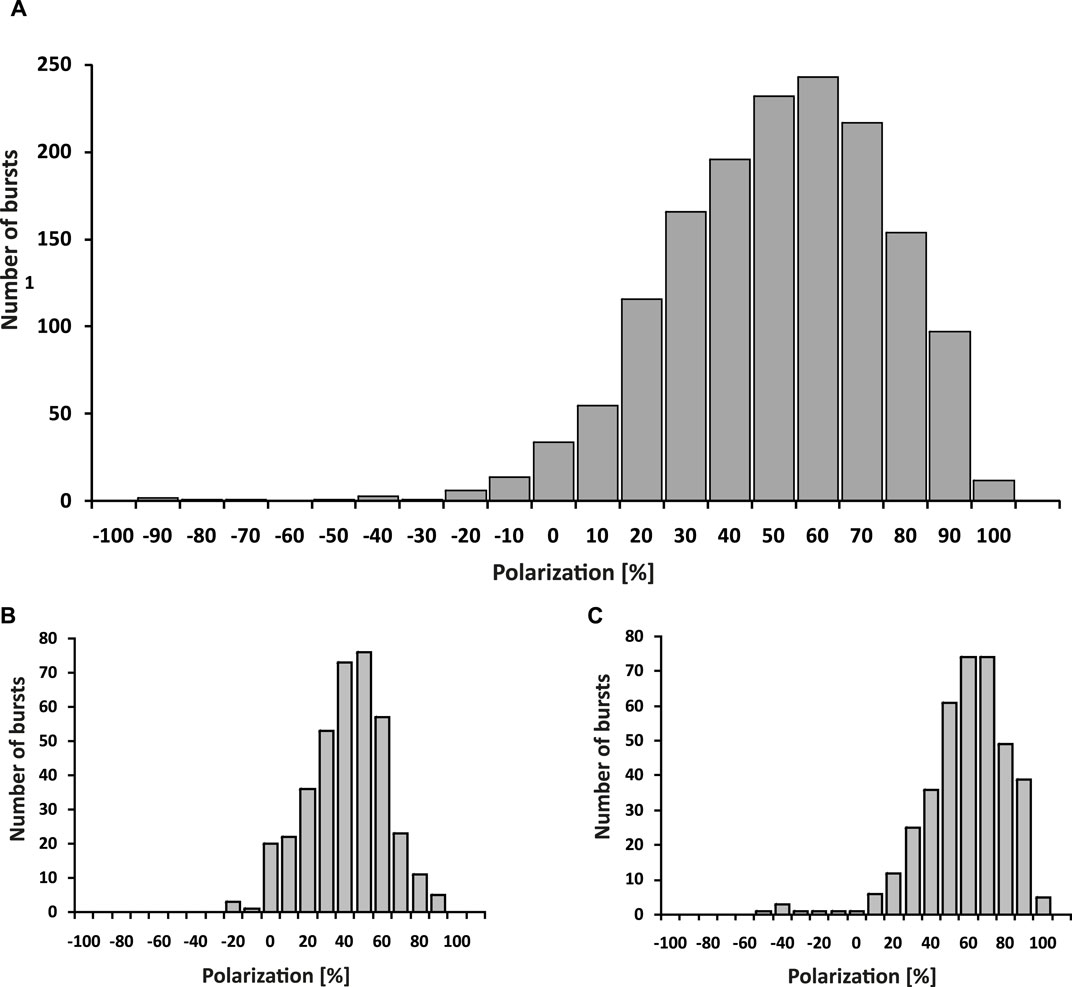
Figure 2. Histograms of spikes distribution by polarization: (A) for all analyzed bursts, (B, C) for some 30 min intervals. The values with plus and minus sign correspond to the right-handed and left-handed polarization respectively.
The distributions obtained by us for the decameter spikes confirm the thesis that spikes can reveal both left and right circular polarization and its value varies from 0 up to 100% (Gary et al., 1991; Guedel and Zlobec, 1991; Benz et al., 1996; Wang et al., 1999). In our case the mean value of polarization was about 60% ± 10% and 20% ± 10% for spikes with right and left polarization correspondingly. Based on the presented histograms another conclusion can be drawn - the sign of the spikes polarization practically did not vary during the entire storm.
We also tried to reveal some dependence of spikes polarization on frequency. As a result of the analysis no specific dependency was found–all the values of polarization were randomly located on the frequency–polarization plane. And the average values at individual frequencies were in the range 40–70% ± 10%.
Another interesting result is a time shift (advance or delay) between polarization and flux maxima. An example of such advance is shown in Figure 3. In this specific case the advance time is 0.1 s. As a result of the statistical analysis the distribution histogram of the time shifts was obtained (Figure 4). From this distribution it is visible that in the 70% of cases the maximum of polarization advanced the maximum of the flux in average by 0.25 s, in 22% the maxima coincided, and in 8% the delay was observed inaverage by 0.14 s.
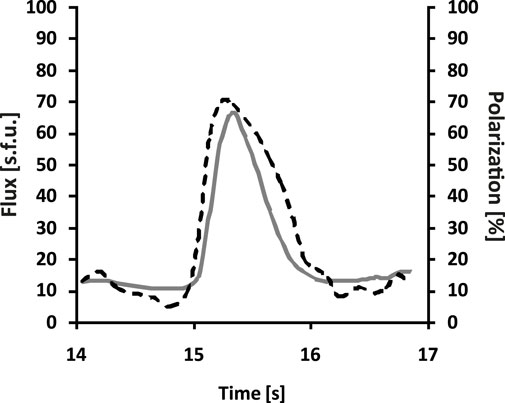
Figure 3. Intensity and polarization profiles of the spike at frequency 23.5 MHz at the time 10:05:14–10:05:17 UT. The solid and dashed curves correspond to flux and polarization respectively.
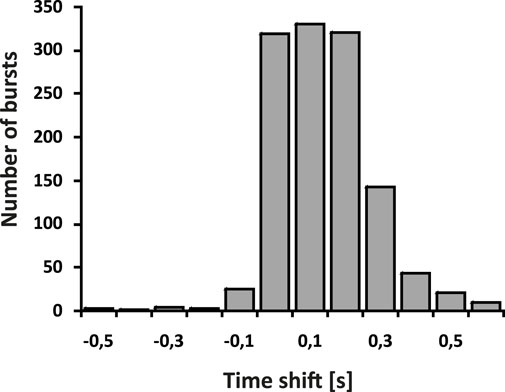
Figure 4. The distribution histogram of time shift polarization maximum relative to the flux maximum. Positive and negative values correspond to advance and delay respectively.
It is important to note that the degree of spikes polarization and its behavior with respect to the radiation flux presented in this work agree well with the results obtained for the Type IIIb bursts in the paper (Melnik et al., 2018). The average value of the Type IIIb bursts polarization varied from 40% ± 10% to 60% ± 10% depending on the day of observation and its sign coincided with the polarization sign of the associated Type III bursts. This result along with the results presented in (Shevchuk et al., 2018) might be additional evidence that spikes and striae, which form Type IIIb burst, are apparently the same type of the solarradio bursts.
4 Discussion
4.1 “Leading spot” rule
Based on the assumptions made in the paper (Payne-Scott and Little, 1951) an attempt to associate spikes activity with the certain active region on the solar disk and to determine the possible mode of bursts emission notably O- or X-modes were made. According to the data obtained with SDO satellite (Solar Dynamic Observatory, https://sdo.gsfc.nasa.gov/) on 14 June 2012 several active regions were observed on the solar disk and named as NOAA 11504-11508. The map of the magnetic field distribution and active regions location on the solar disk is presented in Figure 5. In SDO data the locations with a white colour correspond to the positive magnetic field (North) while black colour represents negative magnetic field (South) (for quires visit https://svs.gsfc.nasa.gov/3713/).
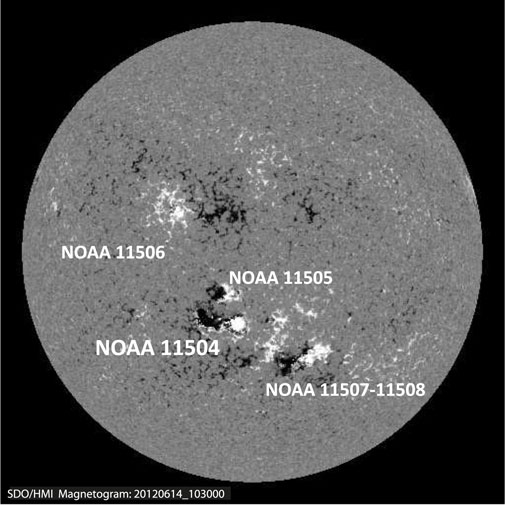
Figure 5. Magnetogram showing the location and polarity of the active regions on the solar disk on 14 June 2012.
Currently we do not have technical facilities to associate the solar radio activity to a particular source region. Instead for this purpose we used other available data from the various sources (for example, https://www.spaceweather.com/, https://tesis.lebedev.ru/) and came to the conclusion that the region NOAA 11504 was the most active on 14 June 2012. During the whole day of observations its activity manifested itself in five to eight flares of C1.six to five class and one flare of M1.9 class. Thus, we associate spikes analyzed in this work exactly with the active regionNOAA 11504.
As it was mentioned earlier, in the majority of the cases spikes had right handed polarization. At the same time the leading spot of the active area NOAA 11504 had north polarity and the trailing the south one (Figure 5). Following the logic of the “leading spot” rule we can conclude that the registered mode of the electromagnetic emission (spikes) in this particular case corresponded to the X-mode. The obtained result does not contradict the results presented in (Payne-Scott and Little, 1951; Guedel and Zlobec, 1991). However, it must be noted here that in the paper (Guedel and Zlobec, 1991) Type III bursts observed simultaneously with the analyzed spikes had opposite polarization that pointed at the O- mode of the emission, thereby confirming the generally accepted mode of the Type III bursts radiation. In our case, as can be seen from Figure 1, Type III bursts as well as spikes had right-handed polarization. Consequently the mode of their emission apparently must also correspond to the X-mode. This result raises doubts concerning the correctness of association of spikes and Type III bursts with the leading spot of the active region NOAA 11504. That might be supported with one of the conclusions made in (Guedel and Zlobec, 1991) that in contrast to the decimetric and microwave ranges in the metric spikes are polarized in the sense ofthe O- mode.
In the papers (Benz et al., 1982; Benz and Guedel, 1987) it was shown that in the meter range the signs of polarization of spikes and associated with them Type III bursts in most cases coincide. The determined emission mode in the frames of “leading spot” rule corresponded to the O- mode. Thus, spikes and Type III bursts analyzed in the present study most probably should be associated with the trailing spot of the active region NOAA 11504 which had south polarity. In this case the emission mode of burst of both types will correspond to the O-mode. Such a change of the leading spot on trailing one does not contradict to the “leading spot” rule since judging by the presented magnetogram (Figure 5) the trailing spot is comparable or even larger in a size than the leading one.
4.2 Magnetic field determination
Based on the results presented in (Shevchuk et al., 2016; 2018; Melnik et al., 2018) and present paper we can assume that spikes and striae (fine structure of Type IIIb bursts) are most probably the same type of solar radio bursts. However, these bursts got their names due to different appearance on the dynamic spectrum that apparently indicates the different state of coronal plasma at the moments of their generation. If these bursts are in fact the same type of bursts then they have the same generation mechanism and the emission is generated at the first harmonic of the plasma frequency (see Melnik et al., 2018). Following the assumptions made in (Melnik et al., 2018) and taking into account the fact that the average value of spikes polarization is about 60% ± 10% and the emission corresponds to O- mode we calculated magnetic field in the place of bursts generation.
We suppose that, as in a case of Type IIIb bursts, spikes are generated by the fast electron beams propagating through the coronal plasma. In this case the maximum number of Z waves (Langmuir waves in the plasma without magnetic field) are concentrated near the minimum value of the wave number
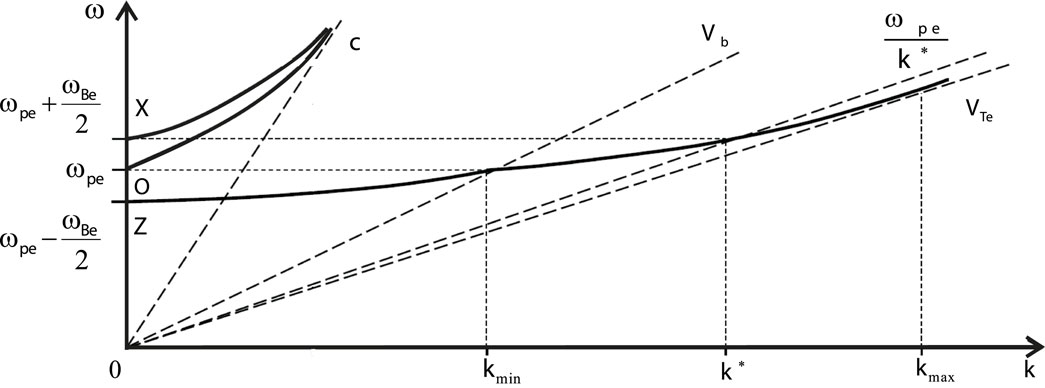
Figure 6. Dispersion curves for Z-, O-, X-waves in plasma with magnetic field (adopted from Melnik, 2018).
The numbers of ordinary or extraordinary waves are determined as definite integral of the spectral energy density of Langmuir waves:
where
After all the transformations and integration of Eqs 2, 3 we obtained the equation for the magnetic field:
Analyzing the obtained expression we can see that the magnetic field is related to the electron thermal velocity, electron beam velocity which is responsible for the spikes generation, plasma frequency and polarization. Thus, knowing spikes polarization from the observations and choosing temperature and beam velocity within reasonable limits we can determine the magnetic field value in the corona at certain height. For example, assuming that at frequency 25 MHz [that in the Newkirk model corresponds to 1.9RS, where RS is the solar radius (Newkirk, 1961)] the coronal plasma temperature equals 1.5MK, and maximum velocity of the electron beam is about 0.2c the value of magnetic field is approximately 0.4 G. The obtained magnetic field is reasonable and does not differ essentially from the value obtained from empirical dependence of magnetic field on height (Dulk and McLean, 1978):
According to Eq. 6 the magnetic field at the height corresponding to plasma frequency of 25 MHz is about 0.58 G. Varying coronal temperature and beam velocity we can obtain comparable values of magnetic field.
Obtained Eq. 5 can be represented as the dependence of magnetic field on distance (R) assuming Newkirk coronal model (Newkirk, 1961):
Comparing Eqs 6, 7 we see that they are close if we assume the coronal plasma temperature of about 1.5 MK and electron beam velocity of approximately 0.17c (Figure 7).
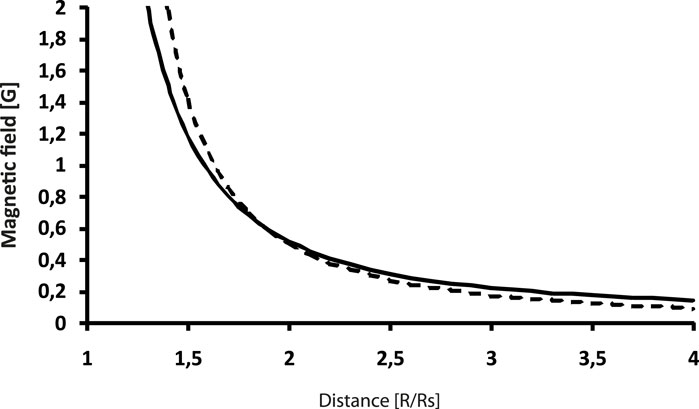
Figure 7. Dependence of the magnetic field on distance from Sun in the models obtained in the present study (solid curve) and in the paper (Dulk and McLean, 1978) (dashed curve).
Taking into account coronal temperature T≈ 0.35 MK and magnetic field B≈ 1.6G, determined by spikes duration and bandwidth for this day earlier (Shevchuk et al., 2016), we calculated the velocity of the electron beam responsible for the spikes generation which was equal about 0.05c. Assuming that spikes and Type IIIb bursts are generated by the similar electron beams then drift rates of Type IIIb bursts, which are in average 3 − 5MHzs−1 (Melnik et al., 2010; 2018), give us linear velocity of the beams 0.09–0.16c. So, obtained in the frames of our assumptions velocity is reasonable.
Thus, knowing spikes polarization from the observations at certain frequency we can determine different parameters of coronal plasma (magnetic field, temperature) on one hand and/or electron beam velocity on another one.
5 Conclusion
In the scope of the present paper the analysis of the decameter spikes polarization properties was performed for the first time. It was shown that in the course of our specific case spikes with right-handed circular polarization were dominant. We found that their polarization varied from 0 up to 100% with the average values 60% ± 10% and 20% ± 10% for the right- and left-handed polarization correspondingly.
Based on the obtained results and in the frames of the “leading spot” rule we linked spikes emission to specific active region on the solar disk, namely, with the trailing spot of NOAA11504 which had south polarity.
We used spikes polarization to determine the value of the magnetic field in the place of their generation and/or electron beam velocity. The obtained values are reasonable and equal approximately 0.6 G or 0.17c respectively.
Data availability statement
The raw data supporting the conclusion of this article will be made available by the authors, without undue reservation.
Author contributions
MS: Formal Analysis, Investigation, Methodology, Supervision, Validation, Writing–original draft, Writing–review and editing. VM: Funding acquisition, Investigation, Methodology, Project administration, Supervision, Validation, Writing–review and editing. AB: Data curation, Funding acquisition, Project administration, Resources, Writing–review and editing. VD: Formal Analysis, Validation, Writing–review and editing. AF: Data curation, Formal Analysis, Software, Writing–review and editing. SP: Writing–review and editing. JM: Writing–review and editing.
Funding
The author(s) declare that financial support was received for the research, authorship, and/or publication of this article. The work was financed within the framework of the state budgetary NDR “Radius” (0122U000616). The work was partially fulfilled in the framework of FP7 project SOLSPANET (FP7–PEOPLE-2010-IRSES-269299) and by project DBOF-12-0261 of the KU Leuven.
Conflict of interest
The authors declare that the research was conducted in the absence of any commercial or financial relationships that could be construed as a potential conflict of interest.
Publisher’s note
All claims expressed in this article are solely those of the authors and do not necessarily represent those of their affiliated organizations, or those of the publisher, the editors and the reviewers. Any product that may be evaluated in this article, or claim that may be made by its manufacturer, is not guaranteed or endorsed by the publisher.
References
Abrami, A. (1976). The solar radio event of January 14, 1971. Sol. Phys. 46, 229–240. doi:10.1007/BF00157569
Allen, C. W. (1947). Solar radio-noise of 200 Mc./s. And its relation to solar observations. Mon. Not. Roy. Astron. Soc. 107, 386–396. doi:10.1093/mnras/107.4.386
Appleton, E., and Hey, J. S. (1946). XII. Solar radio noise.—I. Philos. Mag. 37, 73–84. doi:10.1080/14786444608561327
Barrow, C. H., and Saunders, H. (1972). Fast polarized pulses in decameter-wave radiation from the Sun. Astrophys. Lett. 12, 211.
Benz, A. O., Csillaghy, A., and Aschwanden, M. J. (1996). Metric spikes and electron acceleration in the solar corona. Astron. Astrophys. 309, 291–300.
Benz, A. O., and Guedel, M. (1987). Harmonic emission and polarization of millisecond radio spikes. Sol. Phys. 111, 175–180. doi:10.1007/BF00145450
Benz, A. O., Jaeggi, M., and Zlobec, P. (1982). Fine structure near the starting frequency of solar type III radio bursts. Astron. Astrophys. 109, 305–313.
Bouratzis, C., Hillaris, A., Alissandrakis, C. E., Preka-Papadema, P., Moussas, X., Caroubalos, C., et al. (2016). High resolution observations with Artemis-IV and the NRH. I. Type IV associated narrow-band bursts. Astron. Astrophys. 586, A29. doi:10.1051/0004-6361/201527229
Brazhenko, A. I., Bulatsen, V. G., Vashchishin, R. V., Frantsuzenko, A. V., Konovalenko, A. A., Falkovich, I. S., et al. (2005). New decameter radiopolarimeter URAN-2. Kinemat. i Fiz. Nebesnykh Tel Suppl. 5, 43–46.
Casillas-Pérez, G. A., Jeyakumar, S., Carrillo-Vargas, A., and Pérez-Enríquez, H. R. (2019). Study of solar radio spikes and their relation to energetic solar events. Sol. Phys. 294, 10. doi:10.1007/s11207-018-1390-6
Chernov, G. P. (1977). Morphological characteristics of solar radio bursts of the “spike” type. Sov. Astron 21, 612–625.
De Groot, T. (1960). Dynamic spectra and polarization of small bursts in solar radio emission. Bull. Astron. Inst. Neth. 15, 229–236.
Dulk, G. A., and McLean, D. J. (1978). Coronal magnetic fields. Sol. Phys. 57, 279–295. doi:10.1007/BF00160102
Elgaröy, Ö. (1961). Studies in high-resolution spectrometry of solar radio emission. Astrophys. Norv. 7, 123–172.
Gary, D. E., Hurford, G. J., and Flees, D. J. (1991). First interferometric observations of solar microwave millisecond spike bursts. Astrophys. J. 369, 255. doi:10.1086/169756
Guedel, M., and Benz, A. O. (1990). Time profiles of solar radio spikes. Astron. Astrophys. 231, 202–212.
Guedel, M., and Zlobec, P. (1991). Polarization and emission mode of solar radio spikes. Astron. Astrophys. 245, 299–309.
Heyvaerts, J., Kerdraon, A., Mangeney, A., Pick, M., and Slottje, C. (1978). Polarization and location of metric radiobursts in relationship with the emergence of a new magnetic field. Astron. Astrophys. 66, 81–86.
Jin, S.-Z., Fu, Q.-J., Zhao, R.-Y., and Hu, C.-M. (1990). Spike observations in flares in China. Sol. Phys. 130, 175–182. doi:10.1007/BF00156788
Kai, K. (1970). The structure, polarization, and spatial relationship of solar radio sources of spectral types I and III. Sol. Phys. 11, 456–466. doi:10.1007/BF00153079
Kai, K., Melrose, D. B., and Suzuki, S. (1985). “Storms,” in Solar radiophysics: studies of emission from the Sun at metre wavelengthsEditors D. J. McLean, and N. R. Labrum , 415–441.
Magdalenić, J., Vršnak, B., Zlobec, P., Hillaris, A., and Messerotti, M. (2006). Classification and properties of supershort solar radio bursts. Astrophys. J. Lett. 642, L77–L80. doi:10.1086/504521
Megn, A. V., Sharykin, N. K., Zaharenko, V. V., Bulatsen, V. G., Brazhenko, A. I., and Vaschishin, R. V. (2003). Decameter wavelength radio telescope URAN-2. Radio Phys. Radio Astron. 8, 345–356.
Mel’Nik, V. N. (1995). “Gas-dynamic” expansion of a fast-electron flux in a plasma. Plasma Phys. Rep. 21, 89–91. doi:10.48550/arXiv.1802.07806
Melnik, V. N., Brazhenko, A. I., Frantsuzenko, A. V., Dorovskyy, V. V., and Rucker, H. O. (2018). Properties of decameter IIIb-III pairs. Sol. Phys. 293, 26. doi:10.1007/s11207-017-1234-9
Mel’Nik, V. N., and Kontar, E. P. (2003). Plasma radio emission of beam-plasma structures in the solar corona. Sol. Phys. 215, 335–341. doi:10.1023/A:1025689116449
Mel’nik, V. N., Lapshin, V., and Kontar, E. (1999). Propagation of a monoenergetic electron beam in the solar corona. Sol. Phys. 184, 353–362. doi:10.1023/A:1005191910544
Melnik, V. N., Rucker, H. O., Konovalenko, A. A., Shevchuk, N. V., Abranin, E. P., Dorovskyy, V. V., et al. (2010). “Type IIIb bursts and their fine structure in frequency band 18-30 MHz,” in American institute of Physics conference seriesEditors S. K. Chakrabarti, A. I. Zhuk, and G. S. Bisnovatyi-Kogan, 445–449. doi:10.1063/1.3292552
Melnik, V. N., Shevchuk, N. V., Konovalenko, A. A., Rucker, H. O., Dorovskyy, V. V., Poedts, S., et al. (2014). Solar decameter spikes. Sol. Phys. 289, 1701–1714. doi:10.1007/s11207-013-0434-1
Messerotti, M., Nonino, M., and Zlobec, P. (1985). Polarization and brightness temperature of ’spike’ bursts related to metric Type IV solar radio events. Mem. Soc. Astron. Ital. 56, 795–799.
Newkirk, G. (1961). The solar corona in active regions and the thermal origin of the slowly varying component of solar radio radiation. Astrophys. J. 133, 983. doi:10.1086/147104
Payne-Scott, R., and Little, A. G. (1951). The position and movement on the solar disk of sources of radiation at a frequency of 97 Mc/s. II. Noise storms. Aust. J. Sci. Res. A Phys. Sci. 4, 508. doi:10.1071/CH9510508
Shevchuk, M., Melnik, V., Poedts, S., Dorovskyy, V., Magdalenic, J., and Konovalenko, A. (2018). “On the observational properties of the decameter striae,” in 2018 2nd URSI Atlantic Radio Science Meeting (AT-RASC), Gran Canaria, Spain, 28 May - 1 June 2018, 40–43.
Shevchuk, N. V., Melnik, V. N., Poedts, S., Dorovskyy, V. V., Magdalenic, J., Konovalenko, A. A., et al. (2016). The storm of decameter spikes during the event of 14 June 2012. Sol. Phys. 291, 211–228. doi:10.1007/s11207-015-0799-4
Tan, B. L., Cheng, J., Tan, C. M., and Kou, H. X. (2019). Scaling-laws of radio spike bursts and their constraints on new solar radio telescopestwo. Chin. Astronomy Astrophysics 43, 59–74. doi:10.1016/j.chinastron.2019.02.005
Wang, M., Fu, Q. J., Xie, R. X., and Huang, G. L. (1999). Observational characteristics of weak polarized microwave spikes. Sol. Phys. 189, 331–344. doi:10.1023/A:1005213701438
Zakharenko, V., Konovalenko, A., Zarka, P., Ulyanov, O., Sidorchuk, M., Stepkin, S., et al. (2016). Digital receivers for low-frequency radio telescopes UTR-2, URAN, GURT. J. Astronomical Instrum. 5, 1641010–1641738. doi:10.1142/S2251171716410105
Keywords: dynamic spectrum, decameter radio bursts, spikes, polarization, active regions, magnetic field
Citation: Shevchuk M, Melnik V, Brazhenko A, Dorovskyy V, Frantsuzenko A, Poedts S and Magdalenic J (2024) Polarization properties of the decameter spikes. Front. Astron. Space Sci. 11:1396326. doi: 10.3389/fspas.2024.1396326
Received: 05 March 2024; Accepted: 19 April 2024;
Published: 09 May 2024.
Edited by:
Xinhua Zhao, Chinese Academy of Sciences (CAS), ChinaReviewed by:
Baolin Tan, National Astronomical Observatories (CAS), ChinaPietro Zucca, ASTRON, Netherlands
Copyright © 2024 Shevchuk, Melnik, Brazhenko, Dorovskyy, Frantsuzenko, Poedts and Magdalenic. This is an open-access article distributed under the terms of the Creative Commons Attribution License (CC BY). The use, distribution or reproduction in other forums is permitted, provided the original author(s) and the copyright owner(s) are credited and that the original publication in this journal is cited, in accordance with accepted academic practice. No use, distribution or reproduction is permitted which does not comply with these terms.
*Correspondence:Mykola Shevchuk, bXlrb2xhLnNoZXZjaHVrQHJpYW4ua2hhcmtvdi51YQ==
 Mykola Shevchuk
Mykola Shevchuk